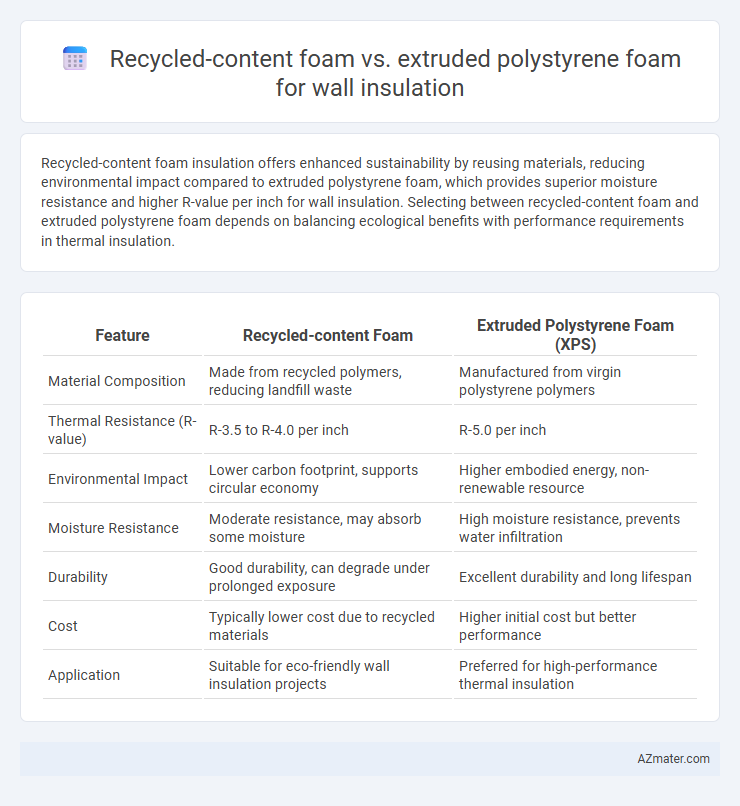Recycled-content foam insulation offers enhanced sustainability by reusing materials, reducing environmental impact compared to extruded polystyrene foam, which provides superior moisture resistance and higher R-value per inch for wall insulation. Selecting between recycled-content foam and extruded polystyrene foam depends on balancing ecological benefits with performance requirements in thermal insulation.
Table of Comparison
| Feature | Recycled-content Foam | Extruded Polystyrene Foam (XPS) |
|---|---|---|
| Material Composition | Made from recycled polymers, reducing landfill waste | Manufactured from virgin polystyrene polymers |
| Thermal Resistance (R-value) | R-3.5 to R-4.0 per inch | R-5.0 per inch |
| Environmental Impact | Lower carbon footprint, supports circular economy | Higher embodied energy, non-renewable resource |
| Moisture Resistance | Moderate resistance, may absorb some moisture | High moisture resistance, prevents water infiltration |
| Durability | Good durability, can degrade under prolonged exposure | Excellent durability and long lifespan |
| Cost | Typically lower cost due to recycled materials | Higher initial cost but better performance |
| Application | Suitable for eco-friendly wall insulation projects | Preferred for high-performance thermal insulation |
Introduction to Wall Insulation Materials
Recycled-content foam and extruded polystyrene (XPS) foam are popular materials for wall insulation due to their thermal resistance and moisture barriers. Recycled-content foam leverages post-consumer waste, reducing environmental impact while providing R-values typically ranging from 3.5 to 4.5 per inch, ensuring energy efficiency. Extruded polystyrene foam offers higher R-values around 5 per inch and superior compressive strength, making it suitable for consistent insulation performance in residential and commercial wall applications.
What is Recycled-Content Foam?
Recycled-content foam is an insulation material made from post-consumer or post-industrial plastic waste, repurposed into foam panels that provide thermal resistance for walls. It often incorporates recycled polystyrene or polyurethane, contributing to reduced environmental impact by diverting plastic from landfills. This foam type offers comparable R-values to conventional options while promoting sustainability in building insulation.
Defining Extruded Polystyrene (XPS) Foam
Extruded Polystyrene (XPS) foam is a rigid insulation material known for its high compressive strength, moisture resistance, and thermal performance, typically featuring a closed-cell structure with R-values around 5 per inch. Recycled-content foam, often made from recycled plastics and polyurethane, can vary in insulation efficiency and durability but emphasizes environmental sustainability by reducing landfill waste. XPS foam is commonly used in wall insulation for its durability and resistance to water absorption, making it suitable for below-grade and exterior applications where long-term thermal resistance and structural integrity are critical.
Environmental Impact Comparison
Recycled-content foam insulation reduces waste by utilizing post-consumer materials, significantly lowering landfill contributions and reducing the carbon footprint compared to traditional manufacturing processes of extruded polystyrene (XPS) foam. Extruded polystyrene foam, although providing high thermal resistance and moisture resistance, relies on petroleum-based chemicals and blowing agents with high global warming potential, exacerbating environmental harm. Choosing recycled-content foam optimizes sustainability by minimizing resource extraction and greenhouse gas emissions, supporting eco-friendly building practices.
Thermal Performance and R-Value Differences
Recycled-content foam insulation typically offers moderate R-values around 3.5 to 4 per inch, making it less thermally efficient compared to extruded polystyrene (XPS) foam, which delivers higher R-values between 5 and 5.5 per inch due to its closed-cell structure. The superior moisture resistance and consistent thermal performance of XPS contribute to better long-term effectiveness in wall insulation applications. Choosing XPS results in enhanced insulation efficiency and energy savings, while recycled-content foam provides an eco-friendly alternative with slightly lower thermal performance.
Moisture Resistance and Durability
Recycled-content foam offers moderate moisture resistance but can absorb water over time, potentially compromising its insulating properties and structural integrity. Extruded polystyrene foam (XPS) exhibits superior moisture resistance due to its closed-cell structure, making it less prone to water absorption and ideal for high-humidity environments. In terms of durability, XPS foam maintains long-term structural stability and thermal performance, while recycled-content foam may degrade faster when exposed to prolonged moisture or environmental stress.
Cost Considerations and Availability
Recycled-content foam insulation typically offers lower upfront costs due to the use of reclaimed materials, making it an economical choice for budget-conscious projects. Extruded polystyrene (XPS) foam, while generally more expensive, provides consistent availability from major suppliers and superior thermal resistance, which can result in long-term energy savings. Availability of recycled-content foam may vary by region and manufacturer, requiring verification for specific project timelines and quantities.
Installation Methods and Ease
Recycled-content foam typically comes in flexible boards or panels that are easy to cut and fit into irregular wall cavities, allowing for faster installation with minimal waste. Extruded polystyrene (XPS) foam is rigid and requires precise measurement and cutting to ensure tight seams for optimal thermal performance, making installation slightly more labor-intensive but resulting in a consistent insulation layer. Both materials benefit from adhesive application or mechanical fasteners, but recycled-content foam often offers easier handling and adaptability during complex installations.
Health and Indoor Air Quality Factors
Recycled-content foam insulation often contains fewer volatile organic compounds (VOCs) than extruded polystyrene (XPS), contributing to better indoor air quality and reduced health risks such as respiratory irritation and chemical sensitivity. XPS foam typically off-gasses styrene and other harmful chemicals, which can negatively impact indoor air quality, especially in tightly sealed buildings. Choosing recycled-content foam can support healthier indoor environments by minimizing exposure to toxic emissions and enhancing overall occupant well-being.
Choosing the Best Insulation for Your Project
Recycled-content foam offers enhanced environmental benefits by utilizing post-consumer materials, reducing landfill waste and lowering greenhouse gas emissions, making it an ideal choice for eco-conscious wall insulation projects. Extruded polystyrene (XPS) foam provides superior moisture resistance and a higher R-value per inch, delivering strong thermal performance and durability in damp or high-humidity environments. Selecting the best wall insulation depends on project priorities such as sustainability, insulation efficiency, moisture conditions, and budget constraints.

Infographic: Recycled-content foam vs Extruded polystyrene foam for Wall insulation
 azmater.com
azmater.com